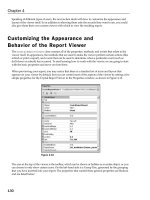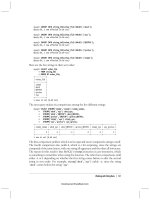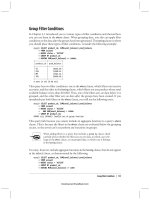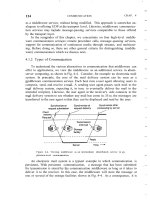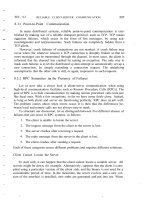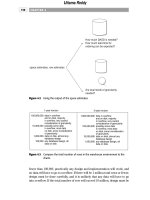head first java second edition phần 5 pptx
Bạn đang xem bản rút gọn của tài liệu. Xem và tải ngay bản đầy đủ của tài liệu tại đây (3.04 MB, 68 trang )
How
do
you
lnveke
a
superclass
cOMstructot1
You
might
think
that
somewhere
in, say,a
Duck
constructor,
if
Duck
extends
Animal
you'd
call
Anirnalj).
But that's
not
how it works:
public
class
Duck
exttmds
Animal
{
int
size;
public
Duck(int
newSize)
{
1(,~t>~
4-
Animal
()
i
~
NOI
ti:
.
size
=
newSize;
.
hl~
's
lIot
Ie
II
}
~.
}
The
only way to call a
super
constructor
is by calling superi),
That's
right-super()
calls
the
super
consIn.tctor.
What
are
the
odds?
public
class
Duck
extends
Animal
{
int
size;
public
Duck(int
newSize)
{
constructors
and
gc
And
how
is
it
that
we've
gotten
away
without
doing
it?
You
probably
figured
that
out,
Our
good
friend
the
compiler
puts
in a call
to
super()
Ifyou
don't.
So
the
complier gets involved in
constructor-making in two ways:
<D
If
you
don't
provide
a
constructor
The
complier
puts
one in
that
looks like:
public
ClassName()
super
() ;
super
();
~(-~
size
=
newSize;
®
I'
you
do
provide
a
constructor
but
you
do not
put
in
the
call
to
superl)
A call to
suPer()
in
your
constructor
puts
the
superclass
constructor
on
the
top
of
the
Stack,
And
what do you
think
that
superclass
constructor
does?
Calls
its
superclass
constructor.
And
so it
goes
until
the
Object
constructor
is
on
the
top
of
the
Stack,
Once
Object()
finishes, it's
popped
off
the
Stack
and
the
next
thing
down
the
Stack
(the
subclass
constructor
that
called Objul(») is now on top.
That
constructor
finishes
and
so it goes until
the
original
constructor
is on
the
top
of
the
Stack,
where
it
can
now
finish,
The
compiler
will
put
a call to supert) in
each of your overloaded constructors."
The complier-supplied call looks like:
super();
It always looks like that. The compiler-
Inserted (all to
supert) Is always a no-arg
call. If
the
superclass has overloaded
constructors,
only
the
no-arg one iscalled.
'Unlesstheconslructor
calls
ano
ther
overloaded
co
ns
tru
ctor (y
ou
'll
see
thai
ina
few
pages).
you
are
h
er
e
~
253
object
lifecycle
Catt
the
child
exist
before
the
parents?
If
you
think
of
a superclass as
the
parent
to the subclass child,
you can figure
out
which has to exist first, The
superdass
parts
ofan
object
have to
beJUUy-jormed
(completely built) btfore the
subclass
parts
can be constructed. Remember,
the
subclass object
might
depend
on things it
inherits from the superclass, so it's
important
that
those
inherited
things be finished. No
way
around
it.
The
superc1ass
constructor
must finish before its subclass
constructor
,
Look
at the Stack series on page
248
again,
and
you can see
that
while
the
Hippo
constructor
is
the
firstto be invoked (it's
the
first
thing
on
the
Stack), it's
the
last
one
to completeI Each subclass
constructor
immediately invokes its own superclass
constructor, until the Object
constructor
is on
the
top
of
the
Stack,
Then
Object's
constructor
completes
and
we
bounce
back down
the
Stack to Animal's
constructor. Only afterAnimal's
constructor
completes
do
we finally come back down to finish
the
rest of the
Hippo
constructor
.
For
that reason:
The
call
to superO
must
be
the
first
statement
In
each
eenetrueterr'
Possible
constructors
for
class
Boop
o
public
Boop
() {
super
() ;
0'
public
Boop
(int
i)
(
sup&r()
;
size
= i ;
}
"There'san exception to this rule:you'lileam It on page 252.
254 chapter 9
o
public
Boap
( ) (
I
0'
public
Boop
(int
i)
size
'"
i;
f-~
o
public
Boop
(int
i)
(
BAD!!
Thi5 '
/'
VOlt
'f.
'4'otlt lOll,l>'j
size
=
i;
.1,
t-ill
txp/·(;'.l'
[It.
U1~
~II
to
I
'T.Jy
pc-I:
super
() ; ClllythiM I
lIoP~)
belo'o.l
.J e 5e.
Superclass
eoastrueters
with
argUtMettfs
What
if
the
superclass
constructor
has
arguments?
Can you pass
something
in to
the
super() call?
Of
course.
If
you
couldn't.
you'd
never
be able to
extend
a class
that
didn
't have a no-arg constructor,
Imagine
this
scenario
: all animals have a
name.
There's
a gelName()
method
in class Animal
that
returns
the
value
of
the
name instance variable.
The
instance variable is
marked
private,
but
the
subclass
(in this case,
Hippo)
inherits
the
getName()
method.
So
here's
the
problem:
Hippo
has a
getName()
method
(through
inheritance),
but
does
not
have
the
name
instance
variable.
Hippo
has to
depend
on
the
Animal
part
of
himself
to
keep
the
name
instance variable,
and
return
it when
someone
calls
geLNa1T/~()
on a
Hippo
object. But how
does
the
Animal
part
get
the
name?
The
only
reference
Hippo
has to
the
Animal
part
of
himself
is
through
supert), so that's
the
place
where
Hippo
sends
the
Hippo's
name
up
to
the
Animal
pan
of
himself, so
that
the
Animal
part
can
store
it in
the
private
n~me
instance variable.
public
abstract
class
Animal
{
private
String
name;
~
All
al'l
i",al
s
(i"dwii,,~
slobdas.ses)
hall' a "a",e
public
String
getName
()
(~~
9~k
"'rl::~od
return
name;
Ill
ppo
i
ll
herib ihai
constructors
and
gc
Animal
private
String
name
Animal(StTing
n)
String
getNameO
T
Hippo
Hlppo(String
n)
[other
Hippo-spe-
cific
methods]
public
class
Rippo
extends
Animal
(
public
Animal(String
name
=
theName;
public
class
MakeHippo
(
public
static
void
main(StJ:ing[]
args)
(
NJak
e
d
Ili
Hippo
h =
new
Bippo("Buffy");
~
Il<lrnt
"BI.I(ly~:
f:
SS
;"9
t~e
to~i.,.
f ot.
the
Ill
ppo
System.
out.
println
(h.
getName
() ) ;
Hip
I
~
•
The,.
tall
f.h
C"
_
po
5
'hht:r
j~d
Lvt
e
\~
g
e
l:./¥a'fte
()
~
%j ava
MakeHippo
Buffy
you
are
here.
255
calling overloaded
constructors
lt1vokh,g
Ot1e
overloaded
cot1structor
fro",
at10ther
-
constructor.
1\.
constructor can \\ave a
catt to sUfel'O
ott
thisO,
llut
nevel'
\loth!
Tl,e
caU
to this\)
can be used
only in a
condl'uet
o
1',
and
must
he
the
tirs
t
statement in a
Use this\) to catt a
-
constructor trom another
o-vertoad
ed
constructor in
tl,e saute ctas
s.
What
if
you have
overloaded
constructors
that,
with
the
exception
of
handling
different
a.Tg1l!l1ent
types,
all
do
the
same
thing? You
know
that
you
don
't
want
duplicate
code
sitting in
each
of
the
constructors
(pain
to
maintain,
etc
.), so
you'd
like to
put
the
bulk
of
the
constructor
code
(including
the
call to
super())
in
only
om
of
the
overloaded
constructors.
You
want
whichever
constructor
is first
invoked
to call
The
Real
Constructor
and
let
The
Real
Constructor
finish
thejob
of
construction.
It's simple:
just
say this().
Or
this(aString).
Or
this(27, x). In
other
words.
just
imagine
that
the
keyword this is a
reference
to
the
current
object
You
can
say thist) only
within
a
constructor.
and
it
must
be
the
first
statement
in
the
constructor!
But
that's
a
problem.
isn't
it?
Earlier
we said
that
super()
must
be
the
first
statement
in
the
constructor.
Well,
that
means
you
get
a choice.
Every
constructor
can
have
a
call
to
super()
or
thlsO,
but
never
bothl
class
Mini
extends
Car
(
Color
color
;
n,
YIO-ay~
t.o\'\Stvl>Lttx
d
lies
a
d'~
il",lt.
ColO'/"
d"
public
Mini
() {
~s
tnt
ol/CY'\oadtd
Real
this
(Color.
Red)
;
{ '"
Col\3.~-\:.O'I"
(~t
OJIt
that
)
taIls
SIIYcY(»'
public
Mini
(Color
c)
8uper("Mini");
l-(
color
=
c;
JJ
more
ini
tialization
public
Mini
(int
size)
(
thi5(COIor.Re~)
;~
super
(size);
~
WOl'l'i
'4IO\"'k.!!
eall'i
have
r
slJ.r
cy
()
a"d
thisO
;1'1
the
sa
e
lOl'l5tn.tt:or,
bel41/.U
they
cad
lUt
be
the
+il"'St
stau
ent.
256
chapter
9
•
~
YOIJr
pencil
Some
of
the
constructors In the SonOOoo class will
not
compile. Seeifyou can recognlze which constructors are
not
legal. Match
the
compiler errors
with
the SonOfBoo
constructors
that
caused them, by drawing a Iine from
the
compiler error to the "bad"constructor.
public
class
Boo (
public
Boo(int
i)
I
~
public
Boo
(String
s)
(
public
Boo(Strlng
8,
int
i)
{ }
class
SonOfBoo ext:4ilnds Boo (
public
SonOfBoo()
super
("boo")
;
public
SonOfBoo(int
i)
(
super
("Fred")
;
public
SonOfBoo(Strinq
s)
{
supar(42);
public
SonOfBoo(int
i,
String
s)
{
}
public
SonOfBoo(Strinq
8.
String
b,
String
c)
(
8upar(a,b);
public
SonOfBoo(int
i,
lnt
j)
(
supar("man",
j);
public
SonOfBoo(int
i,
int
x,
lnt
y) {
super(i,
"star");
constructors
and
gc
I
I
Malee
i-/;
Siitle
I
Roses
Ore
red.
v
You,
pa,en~
Ci
'Iolets
are
blue.
Th
omen,s,
It':
, e superc/ass r aybefo,eyou
I
formed
b
~
parts
of
an ob ' .
,
elOTe
th lJectmu
exist. Just
I'k e
new
sUbc/as sr be
fU/ly_
been b I e there's no w s Object can
Orn
before
You ayYou could h
r parents. ave
you are here . 257
public
void
sleep()
s =
7;
J<::-
~-tP
\
\\
\-lat,
\c.oj
~f\~
.;
1It:<"t.\
.
1Pt$
object
li
fespan
Now
we
know
how
an
object
Is
boyn,
but
how
IOt1g
does
an
object
live?
An
object's
life
depends
entirely on
the
life
of
references
referring to it-
If
the
reference
is
considered
"alive", the
object is still alive on
the
Heap
.
If
the
reference
d.ies
(and
we'll
look at
what
that
means
injust
a
moment)
.
the
object
wiU
die.
So
if
an object's life
depends
on
the
reference
variable's life,
how
long
does
a variable live?
That
depends
on
whether
the
variable is a localvariable
or
an instancevariable.
The
code
below shows the life
ofa
local variable.
In
the example,
the
variable is a primitive.
but
variable lifetime is
the
same
whether
it's a primitive
or
reference
variable.
public
class
TeatLifeOne
public
void
read()
{
r ,
int
s '"
42;
~(
__
.s
;s
oSlo
sleep
() ;
""rl:.hoc/
ped
to
th
d ' So
if.
td
,i
"'eddO
PlYWh&e
else
~
(;
be
~d
{
258
hapter
9
~
A
local
variable
lives
only
within
the
method
that
declared
the
variable.
public
void
read()
(
int
s =
42;
II's'
can
be
used.
on.1y
II
within
th.is
method.
II
When
this
mathod
ends,
II's'
disappeaLs
completely.
Variable 's' can be used only
within
the
readOmethod. In other words. the variable
IsIn scope
only
withIn
Its own
method.
No
other code In the class(or any other class)
can see's'.
• An
instance
variable
lives
as
long
as
the
object
does.
If
the
object
is
still
alive,
so
are
its
instance
variables.
public
class
Life
(
int
size;
public
void
setSize(int
s)
size
=
s;
II's'
disappears
at
the
/ I
end
of
this
method,
II
but
'size
'
can
be
used
II
anywhere
in
the
class
Variable '5' (this time a method parameter)
Is In scope only
within
the setSize()
method. But instance variable size is
scoped to the life of the object as opposed
to
the life of the method.
The
difference
between
life
and
scope
for
local variables:
Life
A local variable is alioeas
long
as its
Stack
frame
is
on
the
Stack.
In
other
words,
until the
method.
completes.
Scope
A local variable is in
scope
only within
the
method
in
which
the
variable was
declared.
When
its
own
method
calls
another,
the
variable is alive,
but
not
in
scope
until
its
method
resumes.
You
canusea variable only
when it isin
scope.
constructors
and
gc
public
void
doStuff(}
boolean
b ""
true;
go
(4)
;
}
publio
void
go(int
x) {
int
z x +
24;
crazy()
;
/ /
imagine
more
code
here
public
void
crazy()
char
c
III
'a';
While a local
variable
is alive, its state persists.
As
long
as
method
doStuffO
is
on
the
Stack,
for
example,
the
'b'
variable keeps its value.
But
the
'b'
variable
can
be
used
only while
doStuffO's
Stack
frame
is
at
the
top. In
other
words, you
can
use
a local variable onlywhile
that
local variable's
method
is actually
running
(as
opposed
to
waiting
for
higher
Stack
frames
to
complete).
o
doStuff()
goes
onthe
stack.
Variable
'b' is
alive
andIn
scope.
o
goO
plops
ontopof
the
Stack.
'x' and
't
arealive
and
in
scope,
and
'b' Isalivebutnof
in
scope.
e
crazyO
Is
pushed
onto
the
Stack,
with
'c'now
alive
andIn
scope.
The
other
three
variables
arealivebutoutof
scope.
oCfilZ'/O
completes
and
Is
popped
offthe
Stack,
so
'(j
is out ofscope
and
dead,
When
goO
resumes
where
It left
off, 'x'
and
'z'
are
both
alive
and
back
In
scope.
Variable
'b'
16
stili
alive
butoutof
scope
(until
goO
completes).
you
are
here
~
259
object
lifecycle
What
about
referettce
variables?
The
rules
are
the
same
for
primtives
and
references.
A
reference
variable
can
be
used
only
when
it's in
scope.
which
means
you
can't
use
an
object's
remote
control
unless you've
got
a
reference
variable
that's
in scope.
The
Teal
question
is,
"How
does
variable life
affect
object life?"
An
object
is alive as
long
as
there
are
live
references
to it,
If
a
reference
variable goes
out
of
scope
but
is still alive,
the
object
it
refers
to is still
alive
on
the
Heap.
And
then
you
have to ask
"What
happens
when
the
Stack
frame
holding
the
reference
gets
popped
off
the
Stack at
the
end
of
the
method?"
If
that
was
the
only live
reference
to
the
object,
the
object
is
now
abandoned
on
the
Heap.
The
reference
variable
disintegrated
with
the
Stack
frame,
so
the
abandoned
object
is now, officially, toast.
The
trick is to know
the
point
at
which
an
object
becomes
eligible
forgarbage
collection:
Once
an
object
is eligible for
garbage
collection
(Ge),
you
don't
have
to worry
about
reclaiming
the
memory
that
object
was
using.
If
your
program gets low
on
memory,
GC
will destroy
some
or
all
of
the
eligible
objects, to
keep
you
from
running
out
of
RAM. You
can
still
run
out
of
memory,
but
not
before
all eligible objects have
been
hauled
off to
the
dump.
Your
job
is
to
make
sure
that
you
abandon
objects (i.e,
make
them
eligible for GC)
when
you're
done
with
them,
so
that
the
garbage
collector
has
something
to reclaim.
lfyou
hang
on
to objects, GC
can't
help
you
and
you
run
the
risk
of
your
program
dying a painful
out-of-memory
death.
Anobject's life
has
no
value.
no meaning. no
rem.
unless aomebody
has a reference to it.
n
you
can't
get to it.
you
can't
ask
it
to do
anything and
it's
jUst
a
bigfat
waste
of
bit&.
But
i'
anobject is
unreachable. the
Garbage
CoUet:t«
will
f1gure
that
out
Sooner
or
later.
that
object'8
gom'down
An
object
becomes
eligible
for
GC
when
its
last
live
reference
disappears.
260
chapter 9
Three
ways
to
get
rid
of
an
object's
reference:
G) The
reference
goes
out of scope, permanently L
, , dies
a~
void
go
() {
~t~t:YtrLt
z.
}
Life
z = new
Life
() ;
~
e 4
J
",dhod
® The
reference
is assigned
another
object
.
ha 4~
~
~
o'o~el.t.
,s
0 ,
-to
Life
z =
new
Life
();
, /
the
~;y-S,
_YO",,,,e&
z '"
new
Life
() ;
~
"''''''
z.;1
yeyY-;,
a
TIt'"
o\:>jtt.t
'3' The reference is explicitly set to null
L'
"L~~ed
\:!,J
~
t.
do"
tt.'{. \1 (1<1 I
Life
z '"
new
Li
fa
() ; the iyS. '
.1~
_yo
",e& .
z =
null;
(-
",'neYl
z. \S
l)
r" J
Object-killer
#1
Reference
goes
out
of
scope,
permanently.
public
class
StaclcR.ef
{
public
void
foof()
(
barf
() ;
public
void
barf()
(
Duck d : new
Duck()
;
o
loof(J
Is
pushed
ontothe
Stack,
no
variables
are
declared.
I
I
I
I
I
I
I
I
constructors
and
gc
o
barf(J
Is
pushed
ontothe
Stack,
where
It
declares
a
reference
variable,
and
creates
a
new
objectas-
signed
to that
reference.
The
objectIs
created
on
the
Heap,
andthe
refer-
ence
Is
alive
andIn
scope.
e
bartO
completes
andpops
offthe
Stack.
Its
frame
disintegrates,
so 'd' Isnow
dead
and
gone.
Execution
returns to
100'0,
but
100(0
can
't use'd' .
Uh-oh.
TIll:
'd'
variable
w~t
d'Na,!
'Nne"
th~
bar·W
SUlk
t
a",e
'Na~
blo'Nft
o-f.f
the
stalk, so
tht
Dutlt
is
aba"dClr\td
.
~arba~t:
lollak
ba
it.
yo u
are
here
~
261
object
life
cycl
e
Dude,all you
had to do was
reset
the
r~ference.
Guess
they didn't have
memory
management back then.
public
void
qo()
{
d = naw
Duck
() ;
Duck
d =
new
Duck();
public
class
ReRef
{
Object-killer
#2
Assign
the
reference
to
another
object
o
o
The
new
Du.tk.
~oes
on t he
!leaf,
e~et"tnLeci
b~
'ei',
~nte
'0' is
cln
inSt.a!'lte
variable,
tne
D",-\I.
will
live
as
\Ol'l~
as
~e
ReRt.t
obit.d:.
that
il\5-t.al'ltiaW
it
is
alive.
l.()\less-
'£1'
is
as.si~\'IeO
a
!'lew
Du.t\l.
objt.tt,
leav\!'I~
the
ori~i\'lal
ah'st)
DlAl.k
objed:.
ahal'loont.o.
That
tirst
D",-k
is
1\0,",
as
~ood
as
dead
262
chapter
9
constructors
and gc
Object
killer
#3
Explicitly
set
the
reference
to
null
Tee
~
D\oll.k
~oes
~
th~
\-ledf'
y~.ftytyo,Ud
b'j'd'.
Sil'\U
'd' is a" inrtal'
IU
vaW'i4bl~,
th~
DlItlc.
will
l
ive
as
l~~
as
th~
R~c.f
obj~l:1:
that.
i~'I\tiat.ed
it.is
alive
.
U"Ies.s-
··
Duck
d
==
new
Duck
()
;
public
void
gal)
(
d
==
nul.l:
public
class
ReRef
{
If
you
use
the
dot
operator
on
a null reference. you'll
get
a
NullPolnterExceptlon at runtime.
You'll
learnall
about
Exceptions In
the
Risky
Behavior chapter.
When you set a reference to
nuJ.l,
you're
deprogramm
ing the remote control.
In
other
words, you've
got
a remote
control,
but
no TV at
the
other
end.A null
reference has bits representIng 'null'
(we
don't
know
or care
what
those bits are,as
long
as
the
NM
knows).
If you have an unprogrammed
remote
control, In the real world,
the
buttons
don't
do anythlng when you press them.But
In Java,you can't press
the
buttons
(I.e.
use the
dot
operator) on a null reference,
because the
NM
knows (this Isa runtime
Issue,
not
acomplier error)
that
you're
expecting a bark
but
there's no Dog there
to do
Itl
The
meaning
of
null
you
are
here
~
263
object
lifecycle
Fireside
Chats
~4
~
Tonight'g
Talk:
An
instance
variable
and
a
looal
variable
discuss life
and
death
(wi~
remarkable
civilliy)
Instance
Variable
I'd
like to go first,
because
I
tend
to be
more
important
to a
program
than
a local variable.
I'm
there
to
support
an object, usually
throughout
the
object's
entire
life. After all,
what's an
object
without
slate?
And
what is
state? Values
kept
in
instana
variables.
No,
don't
get
me
wrong, I do
understand
your
role
in a
method,
it's
just
that
your
life is so
short.
So temporary.
That's
why
they
call
you
guys
"temporary
variables".
My apologies. I
understand
completely.
I
never
really
thought
about
it like that.
What
are
you
doing
while
the
other
methods
are
running
and
you're
waiting for
your
frame
to
be
the
top
of
the
Stack again?
264
chapter 9
Local
Variable
I
appreciate
your
point
of
view,
and
I certainly
appreciate
the
value
of
object
state
and
all,
but
I
don't
want
folks to be misled. Local
variables
are
really
important.
To use
your
phrase
, "After all, what's an
object
without
behaviorr"
And
what is behavior? Algorithms
in
methods.
And
you can bet your bits
there'll
be
some
localvariables in
there
to
make
those
algorithms
work.
Within
the
local-variable community,
the
phrase
"temporary
variable" is
considered
derogatory
. We
prefer
"local", "stack" , "auto-
matic",
or
"Scope-challenged",
Anyway, it's
true
that
we
don't
have a
long
life,
and
it's
not
a particularly
good
life either.
First,
we're
shoved
into
a Stack
frame
with
all
the
other
local variables,
And
then,
if
the
method
we're
part
of
calls
another
method
,
another
frame
is
pushed
on
top
of
us.
And
if
that
method
calls another
method
and
so
on.
Sometimes
we have to wait
forever
for
all
the
other
methods
on
top
of
the
Stack to com-
plete
so
that
our
method
can
run
again.
Nothing.
Nothing
at all. It's like
being
in
stasis-that
thing
they do to
people
in
science
fiction movies
when
they have to travel
long
distances.
Suspended
animation
, really. We
just
sit
there
on
hold
. As
long
as
our
frame
is
still
there,
we're
safe
and
the
value we
hold
is secure,
but
it's a
mixed
blessing
when
our
.
IDstance
Variable
We saw an
educational
video
about
it
once
.
Looks like a
pretty
brutal
ending.
I
mean
,
when
that
method
hits its
ending
curly
brace,
the
frame
is literally blown
off
the
Stack! Now
that's
gotta
hurt.
I live
on
the
Heap,
with
the
objects. Well,
not
with
the
objects, actually in an object.
The
object
whose state I
store
. I have to
admit
life
can
be
pretty
luxurious
on
the
Heap.
A
lot
of
us feel guilty, especially
around
the
holida
ys.
OK, hypothetically, yes, if
I'm
an
instance
variable
of
the
Collar
and
the
Collar gets
GC'd,
then
the
Collar's
instance
variables
would
indeed
be
tossed
out
like so
many
pizza
boxes.
But
I was
told
that
this
almost
never
happens
.
They
let
us drink?
constructors and
gc
Local
Variable
frame gets to
run
again.
On
the
one
hand,
we
get
to be active again.
On
the
other
hand,
the
clock starts ticking again
on
our
short
lives.
The
more
time
our
method
spend
s
running
,
the closer we
get
to
the
end
of
the
method.
We all know
what
happens
then
.
Tell
me
about
it
. In
computer
science
the
y use
the
term
poppedas in "the
frame
was
popped
off
the
Stack".
That
makes it
sound
fun
,
or
maybe like an
extreme
sport.
But
, well, you
saw
the
footage. So why
don't
we talk
about
you? I know
what
my little Stack
frame
looks
like,
but
where
do
you live?
But
you
don't
alwayslive as
long
as
the
object
who
declared
you, right? Say
there's
a
Dog
object
with a Collar
instance
variable.
Imagine
yo
u'
rean
instance
variable
of
the
Collarobject,
maybe a
reference
to a Buckle
or
something
,
sitting
there
all
happ
y inside
the
Collar
object
who's all
happy
inside
the
Dogobject.
But
what
happens
if
the
Dog
wants a new Collar,
or
nulls out its Collar instance variable?
That
makes
the
Collar
object
eligible
for
GC. So
if you
're
an instance variable inside
the
Collar,
and
the
whole Collaris
abandoned
,
what
happens
to you?
And
you believed it?
That's
what
they say to
keep
us motivated
and
productive.
But
aren
't
you
forgetting
something
else?
What
if you
're
an
instance
variable inside
an
object
,
and
that
object is
referenced
onlyby a localvariable?
If
I'm
the
only
reference
to
the
object
you're
in,
wh
en
I go,
you're
coming
with me. Like it
or
not
,
our
fates may be
connected.
So I say we
forget
about
all this
and
go
get
drunk
while
we still can.
Carpe
RAM
and
all that.
you
ar
e
her
e
~
265
exercise: Be the Garbage
Colleclor
BE
the
Garbage
CtJTIector
Wlnch
01'
the
lines
of
code
onthe
rigbt,
if
added
to&
class
on
the
leftat point
A,
would
eaase
exactly
one
additional
object
to
he
eliglhle
for
the
Garbage
Collector?
(AsSUlJle
that
point
A
(licall
more
methods)
will
execute
for
a
long
time,
giving
the
Garbage
Collector
time
to
do
its
stu1f.)
public
class
GC
(
public
static
GC
doStuff()
GC
newGC
= new GCI)i
doStuff2(newGC);
return
newGCi
pUblic
static
void
maln(String
[1
args)
(
GC
gel;
GC
gc2
= new
GCI);
GC
gc3
= new GCI) ;
GC
ge4
=
gc3j
gel
=
doScuff();
II
call
more
methods
public
static
void
doStuff2(GC
copyGC)
GC
localGC
266
chapter
9
1
copyGC =
nulli
2
gc2
=
null;
3
newGC
=
gc3;
4
gel
=
null
;
5
newGC =
null;
6
gc4
=
null;
7
gc3
=
gC2i
8
gel
=
gc4i
9
gc3
nu
Ll.;
class
Bees
{
Honey I] beeHAj
}
class
Raccoon
{
Kit
Xi
Boney
rh;
}
class
Kit
(
Boney
kh;
}
class
Bear
{
Boney hunnYi
}
constructors and gc
In this code example, several new objects are created.
Your challenge is to
find
the
object
that
is 'most popular;
i.e.the one
that
has
the
most reference variables referring
to it. Then list
how
many
total
references there are for
that
object, and what they are! We'll start by poi nti ng
au
t
one of the new objects, and its reference variable.
Good Luck!
pUblic
class
Honey {
public
static
void
main(String
[]
arqs)
{
Roney
honeyPot
= new
HoneY()i
Boney I]
ha
=
{honeyPot,
honeyPot,
honeyPot,
honeyPot};
Bees
bl
= new
Bees():
bl.
beeRA =
ha;
Bear
[)
ba
= new
HearlS];
for
(int
x=O; x <
5;
x++)
ba!x]
= new
Hear();
ba[x).hunny
=
honeyPot;
Here's Its reference
variable
·r'.
}
}
}
Kit
k = new
Kit()i
k.kh
'"
honeyPot;
Raccoon
r '" new
Raccoon()i
~
r.rh
=
honeypot:
r.k
'" Xj
k =
null;
II
end
of
main
Here's a new
~
Raccoon objectl
you
are
here
~
267
puzzle: Five Minute Mystery
"We've
run the simulation four times, and the main module's temperature consistently
driftsout
of
nominal towards cold", Sarah said, exasperated.
"We
installed
the
new temp-bats last
week.
The
readings on the radiator bats, designed to cool the living quarters, seem to be within
spec. so
we've
focused
our
analysis on the heat retention bats, the bats that help to warm the quar-
ters."
Tom
sighed, at first it hadseemed that nano-technology was going to really put them ahead
of
schedule.
Now,
with only five weeks left until launch. some
of
the orbiter's key life support
systems were still not passing the simulation gauntlet.
"What
ratios are
you
simulating?",
Tom
asked.
"Well
if
I see where
you're
going, we already thought
of
that", Sarah replied. "Mis-
sion control will not sign
off
on critical systems
if
we run them out
of
spec. We are
required to run the v3 radiator
bat's
SimUnilS in a 2:1 ratio with the v2 radiator's
SimUnits", Sarah continued. "Overall, the ratio
of
retention bots to radiator bats is
supposed to run 4:3."
"How's
power consumption Sarah?",
Tom
asked. Sarah paused. "Well that's
another thing, power consumption is running higher than anticipated. We
've
got a team
tracking that down too, but because the nanos are wireless
it's
been hard to isolate the power
consumption
of
the radiators from the retention bats ." "Overall power consumption ratios", Sarah
continued.
"are designed to run 3:2 with the radiators pulling more power from the wireless grid."
"OK
Sarah",
Tom
said
"Let's
take a look at
some
of the simulation initiation code.
We've
got to find this problem, and find it quick!"
import
java.util.·;
class
V2Radiator
{
V2Radiator(ArrayList
list)
(
for(int
~O;
x<57
x++)
(
list.add(new
SlmUnit{MV2Radiator
U
) ) ;
}
class
VJRadiator
extends
V2Radiator
V3Radiator{ArrayLlst
lqlist)
super
(
19list)
;
for{lnt
gmO;
g<107
q++) {
lqlist.add(new
SimUnit(MVJRadiator
H
» 1
class
RetentionBot
{
RetentionBot(ArrayList
rlist)
{
rlist.add(new
SimOnit(MRetention-»)
268
chapter
9
rIVe-MInute
Mystery
C<intlnued
public
class
TestLifeSupportSim
{
public
stat
ic
void
main(String
[J
args)
{
ArrayList
aList
= new
ArrayList();
V2Radiator
v2 = new
V2Radiator(aList);
V3Radiator
v3 = new
V3Radiator(aList);
for(int
z=O;
z<20;
z++) {
RetentionBot
ret
= new
RetentionBot(aList);
class
SimUnit
{
String
botType;
SimUnit(String
type)
{
botType
=
type;
}
int
powerUse()
{
if
(URetention
u.equals(botType»
return
2;
else
{
return
4;
}
constructors and gc
Tom gave the code a quick look and a small smile creeped across his lips. I think
I've
found the problem Sarah, and I bet I know by what percentage your power usage readings are off
too!
What did Tom suspect? How could he guess the power readings errors, and what few
lines of code could you add to help debug this program?
you are
here
~
269
object
Iifecycle
1
copyGC =
null;
No - this line
attempts
to
access
a variable
that
is out of scope.
2
ge2
='
null;
OK
- 9c2 was
the
only
reference
variable
referring
to
that
object.
3
newGC
='
gc3;
No - another out of scope variable.
4
gel
=
null;
OK
- gel had
the
only
reference
because
G.C.
newGC
is out of scope.
5
newGC
=
null;
No -
newGC
is out
of
scope.
6
gc4
null;
No - gc3 is still referring to
that
object
.
7
gc3
gc2;
No - 9c4 is still
referring
to
that
object
.
8
gcl
gc4;
OK- Reassigning
the
only
reference
to
that
object.
9
gc3
null;
No - gc4 is still
referring
to
that
object.
Itprobably wasn'ttoo hard to figureout that the HoneyobJectfirstreferredto bythe honeyPotvariableisby
farthe most-popular'object Inthisclass.Butmaybe it wasa littletrickier to see
that
allof the variablesthat
pointfrom the code to the Honeyobject referto the
same ob}edl Thereare atotal of 12active referencesto
this object right before the maln() method completes. The
Ic.kh
variableis
valid
fora while,but kgets nulled
at the end. Sincer.kstili refersto the KItobject,
r.k.kh
(although neverexpllcitydeclared),refersto the object!
}
Kit
k = new
Kit();
k.kh
=>
honeyPot;
Raccoon
r • new
Raccoon();
public
class
Boney {
public
static
void
main(Striog
[)
args)
{
Boney
honeyPot
~
new
Boney();
Boney
[)
ha
=
{noneyPot,
honeypot,
honeyPot,
honeYPot};
Bees
bi
m new
Beesl);
bl.beeHA
=
ha;
Bear
[)
ba = new
BearIS];
for
(int
x-OJ x <
5;
x++) {
ba{x]
= new
Bear():
ba[xj.hunny
c
honeyPot;
L
( endsupnull )
1
J
T
I
1-
r.rh
=
honeyPot:
r.k
- k;
k •
null;
}}
II
end
of
main
270
chapter
9
constructors and ge
Tom noticed that the constructor for the V2Radiator class took an
ArrayList. That meant that every time the V3Radiator constructor was called,
it passed an ArrayList in its supert) call to the V2Radiator constructor. That
meant that an extra five V2Radiator SimUnits were created.
If
Tom was right,
total power use would have been 120, not the 100 that Sarah's expected ratios
predicted.
Since all the Bot classes create SimUnits, writing a constructor for
the SimUnit class, that printed out a line everytime a SimUnit was created,
would have quickly highlighted the problem!
you
are
here 271
10
numbers and statics
Numbers
Matter
Do the Math. But there's more to working
with
numbers than Just doing primitive
arithmetic. You
might
want
to get the absolute value of a number, or round a number,or flnd
the larger of
two
numbers. You mig ht want your numbers to prl nt with exactly
two
decImaI
places,or you
might
want to put commas Into your large numbers to make
them
easier to read.
And what
about
working with dates?You
might
want to
dates In a variety of ways,or even
manipulate dates to say things like,"add three weeks to today's date" And
what
about parsing
a String Into a number?
Or
turning
a
number
into a String? You're In luck. The JavaAPI Is
full
of
handy number-tweaking methods ready and easy to use. But most of them are
static, so we'll
start
by learning
what
it means for avariable or method
to
be static, including constants In
Java-static
final variables.
this
IS a
new
chapt
er
273
Math
methods
MArH
tMethods:
as
close
as
you'll
ever
get
to
a
globa/tMethod
Except
there's
no
global an),lhinginJava. But
think
about
this: what
if
you have a
method
whose
behavior
doesn
't
depend
on an
instance
variable value . Take the
round()
method
in
the
Math class, for
example.
It
does
the
same
thing
every
time-rounds
a floating
point
number(the
argument
to
the
method)
to
the
nearest
integer. Every
time.
lfyou
had
10,000 instances
of
class Math,
and
ran
the
round(42.2)
method,
you'd
get
an
integer
value
of
42. Every time. In
other
words,
the
method
acts on
the
argument,
but
is
never
affected by an instance variable
state.
The
only value
that
changes
the
way
the
round()
method
runs
is
the
argument
passed to
the
methodl
Doesn't
it
seem
like a waste
of
perfectly
good
heap
space
to
make
an instance
of
class
Math
simply to
run
the
round
()
method?
And
what
about
other
Math
methods
like
mint),
which takes two
numerical
primitives
and
returns
the
smaller
of
the
two.
Or
maxj).
Or
abst),
which
returns
the
absolute value
of
a
number.
These methodsnever
we
instance variable values. In fact
the
Math class
doesn't
haveany instance variables. So
there's
nothing
to be
gained
by
making
an instance
of
class
Math. So guess what? You
don't
have to. As a
matter
of
fact. you can 't,
If
you
try
to
make
an
instance
of
class
Math:
Math
mathObject
=
new
Math
()
i
You'll
get
this
error:
Methods
in
the.Math
class
don't
use
any
mstance
variable
values.
Ami
because
the
methods
are
'static',
you
don't
need
to
have
an
illstance
of.Math.
All
you
need
is
the
Math
class.
-
int
x -
Math.round(42.2)
;
int
y =
Math.min(56,12)
i
int
z =
Math.abs(-343);
274 chapter 10
numbers and statics
fhe
differet1ce
betweeM
regular
(.,on-static)
at1d
static
tttethods
Java is object-oriented,
but
once
in a while you have a special case,
typically a utility
method
(like
the
Math
methods),
where
there
is
no
need
to have an instance of
the
class.
The
keyword
static
lets
a
method
run
without any instance
o/the
class.
A static
method
means
"behavior
not
dependent
on an instance variable, so
no
instance/object
is
required
.
Just
the
class."
regular
(non-static)
method
static
method
-
public
class
Soog
( a
'.~'o\(
"a\~
~tt.L~
I~,.{,e
~
" \
.J)
Strine}
title;
~
the
Otha"\~
cJ
tht
yar
public
Sone}
(String
t)
".~~o<!.
tiUe
=
ti
Math
minD
maxD
abs()
public
int
min(int
a,
int
b) (
//returns
the
lesser
of
a
and
b
Song
Song
}
public
void
play()
SoundPlayer
player
= new
SoundPlayer
() i
player
.playSound(tiUB)i
\' J
~e
'title'
nt
l."l'l'tJ\t
"~I\~
Lhe
WTI~
that
L.
1/.11'\<10e IS
~
i"sv"tt.
La\\
yl<l,/{)'
~\a'fS
"e"
'to'J
tltIe
you are
here
~
275
static
methods
.
mi
n
(B8,
86)
;
Math
mlnO
maxO
absO
Call
a
static
method
using
a
class
name
Call
a
non-static
method
using
a
reference
variable
name
V
Song
t2
= new
Song()
;
.play
() ;
What
it
tHea.,s
to
have
a
class
with
static
Ittethods.
Often
(although
not
always), a class with static
methods
is
not
meant
to be instantiated. In
Chapter
8 we talked
about
abstract classes,
and
how marking
a class with the
abstract
modifier makes it
impossible
for
anyone to say 'new' on
that
class type.
In
other
words, it's impossible to
instantiate
an abstract
class.
But you can restrict
other
code
from instantiating
a non,,·abstract class by
marking
the
constructor
private.
Remember
, a
method
marked
private
means
that
only
code
from within
the
class can invoke
the
method.
A
constructor
marked
private means
essentially
the
same
thing-only
code
from within
the
class can invoke
the
constructor
. Nobody can
say
'new'
from
outside
the
class.
That's
how it works
with the
Math
class, for example.
The
constructor
is private, you
cannot
make a new instance
of
Math.
The
compiler
knows that
your
code
doesn't
have
access to that private
constructor
.
This does not
mean
that
a class with
one
or
more
static
methods
should
never be instantiated.
In
fact,
every class you
put
a
mainO
method
in is a class with
a static
method
in itl
Typically,you make a main 0
method
so that you
can
launch
or
test
another
class, nearly
always
by
instantiating a class in main,
and
then
invoking a
method
on
that
new instance.
So you're free to
combine
static
and
non-static
methods
in a class,
although
even a single non-static
method
means
there
must be
S~
way to make an
instance of
the
class.
The
only ways to get a new
object
are
through
'new' or deserialization
(or
something
called
theJava
Reflection API
that
we
don
't go into). No
other
way.
But exactly
WM
says new
can be an interesting question,
and
one
we'Ulook at
a little later in this chapter.
276
chapter
10
Static
tMethods
caM'f
use
t1ot1
statle
(instance)
variables!
Static
methods
run
without
knowing
about
any
particular
instance
of
the
static
method's
class.
And
as you saw on
the
previous pages,
there
might
not
even be
any
instances
of
that
class. Since a static
method
is called using
the
class
(Math.random())
as
opposed
LO an mstance
reference
(t2.playO),
a static
method
can't
refer
to
any instance variables
of
the
class.
The
static
method
doesn't
know which instance's variable
value to use.
If
you
try
to
compile
this
code:
public
olass
Duck (
y,[nit,'I'I
'D
.,.t.~~
~(f.e
~\1,.l.
.
private
lnt
size;
~
(
public
static
void
main
(String[]
arqs)
(
~
System.out.println("SizfiIl
of
duck
is
" +
size):
1.(
fh~e's
d
DlAlk
on
public
void
setsize
(int
09)
~e):eap
So"'ewhet-e,
we
size
=
s;
on
~
KI'IO'w
dboc i
it
numbers
and
statics
If
you
trj
to
use
an
inStance
variable
from
inside
astatic
method.
the
compiler
thitiks.
"I
don't
"know
which
object's
mstance
variable
you're
talking
about!"
If
you
have
ten
DuCK
objects
on
the
heap.
a
static
method
doesn't
"know
about
any
of
them.
}
public
iot
getSize()
return
size;
You'll
get
this
error:
you
are
here
~
277
static
methods
public
void
setsize(int
s)
{
size
= B;
Q:
What
If you
try
to call a
non-static
method
from a
static
method,
but
the
non-static
method
doesn't
use any In-
stance
variables.
WIll
the
compiler allow
that?
A:
No.The compiler knows that
whether you do or do
not
use Instance
variables In a non-static method, you
can.
And think
about
the implications if you
were allowed
to
compile a scenario like
that,
then
what
happens if in the future
you want to change the implementation
of that non-static method so that one day
It
does usean Instance variable? Or worse,
what happens
if
a subclass overrides the
method and uses an Instance variable in
the overriding version?
Q: Icould
swear
I've
seen
code
that
calls a
static
method
uslng a
reference
variable
Instead
of
the
class
name.
A:
You cando that, but
as
your
mother
always told you, "Just because it'slegal
doesn't mean it's good."Although It
works
to call a static method using any instance
of the class,it makes for misleading (less-
readable) code.You
can
say,
Duck
d =
new
Duck():
String[]
s =
{};
d.main(s);
This code is legal, but the complier Just
resolves It
backto the real class anyway
("01( d Is of type Duck, and malnO Isstatic,
so I'll call the static malnO
in classDuck").
In
other
words, using d to Invoke main£)
doesn't Imply that maln() will have any
special knowledge of the object
that
d Is
referencing. It's Just an alternate
way
to
Invoke a static method,
but
the method Is
still static!
Roses
are
red,
bl
mlate
andknown to
00
StCJtlcs
cCJn'.
see
instCJnce
variable state
public
class
Duck
{
}
public
iot
getsize()
return
size;
What
do
non-static
methods
do?
They
usuaUy
use
instance
variable state tv affect the behavior
of
the method. A
getName
()
method
returns
the
value
of
the
name
variable.
Whose
name?
The
object
used
to invoke
the
getNameO
method.
This
won't
compile:
Cdl!il\~
~efs.~()
.t.st
~~
ih~vji:db'e-4JS;
~os)
tpolles
the
si . L J
IU
IA1l.s
U
I)UUI\le
variabje
.
private
iot
size;
public
static
void
main
(Strinq[]
args)
(
System.out.println(~Size
is
~
+
getsize()):
Static
tMethods
cattJt
use
"ott"'statlc
methods
either!
278
chapter 10



